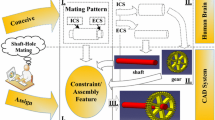Abstract
The advantages and limitations of procedural and declarative approaches for product modeling are discussed. Concepts are developed for modeling all levels of product relations with a uniform set of structures and relationships. It is shown that five basic structures,Part-of, Structuring relation, Degrees of freedom, Motion limits, andFit can be used to define relationships between assemblies, parts, features, feature volume primitives, and evaluated boundaries. Generic relations which facilitate constraint specification between target and reference entities are also presented. Methods for the derivation of the location of an assembly unit from high level constraint specifications, such as mating conditions, and techniques for determining the degrees of freedom, motion limits, and assemblability are required. This can be done by uni-directional parameter derivation in the procedural approach, or by symbolic geometric reasoning or numerical equation solution in the declarative approach. The former is less expensive, easy to implement, avoids conflicts, but leads to combinatorial explosion. The latter is general, flexible, decouples constraint specification from validation, but is expensive, and may require conflict resolution.
Similar content being viewed by others
References
Shah, J. (1991) “Assessment of Features Technology”,J. of CAD,25(5), June.
Libardi, E.C.; Dixon, J.R.; Simmons, M.K. (1988) “Computer environments for the design of mechanical assemblies: A research review”,Engineering with Computers,3, 121–136.
Mantyla, M. (1989) “A modeling environment for top-down design of assembled products”, IBM Research Report, RC 15250 (# 68063).
Eastman, C.M. (1981) “The design of assemblies”, SAE Technical Paper #810197.
Schubert, L.K. (1979) “Problems with parts”,Proceedings of Sixth IJCAl, Tokyo, 778–784.
Schubert, L.K. (1979) “Representing and using knowledge about part”, Computing Science Technical Note, University of Alberta, Edmonton.
Wesley, M.A.; Lozano, P.T.; Lieberman, L.I.; Lavin, M.A.; and Grossman, D.D. (1980) “A geometric modeling system for automated mecahnical assembly”,IBM J. Res. Dev. 24(1), 64–74.
Mantyla, M., (1990) “The Design Browser—a hierarchical part-of graph browser”, IBM Research Report, Watson Research Center, Modeling Science Project.
Lee, K.; and Gossard, D.C. (1985) “A hierarchical data structure for representing assemblies: Part 1”,CAD,17(1), 15–19.
Lee, K.; Andrews, G. (1985) “Inferencing of positions of components in an assembly: part 2”,CAD,17(1), 20–24.
Rocheleau, D.; Lee, K. (1985) “System for interactive assembly modelling”,CAD,19(2), 65–72.
Kim, S.; Lee, K. (1989) “An asembly modelling system for dynamic and kinematic analysis”,CAD,21(1), 2–12.
Popplestone, R.J.; Ambler, A.P.; Bellows, I. (1980) “An interpreter for language for describing assemblies”,AI,14(1), 79–107.
Popplestone, R.J. (1987) “The Edinburgh designer system as a framework for robotics”,Proceeding 1987 IEEE Int. Conf. on Robotics and Automation, 1972–1977.
Freeman, P.; Newell, A. (1971) “A model for functional reasoning in design”,Proceedings Second IJCAI, Los Altos, Calif., 621–633.
Tadepalli, R. (1991) “Feature based assembly modeling of mechanical components”, MS Thesis, Arizona State University, Tempe.
Shah, J.; Tadepalli, R. (1992) “Feature based assembly modeling”, ASME CIE Conf, August 2–6, 1992, San Francisco, CA.
Kramer, G. (1991) “Solving Geometric Constraint Problems”, MIT Press, Cambridge, Mass.
Anantha, R.; Crawford, R.; Kramer, G. (1992) “An architecture to represent over, under, and fully constrained assemblies”, ASME Winter Annual Mtg.
Crawford, R.; Srikantappa, A. (1992) “Intermediate geometry and inter-feature relationships for automatic group technology part coding”, ASME Computers in Engineering Conf, August 2–6, 1992, San Francisco, CA.
Balakrishnan, G. (1993) “Constraint Based Approach to Product Modeling”, MS Thesis, Mechanical & Aerospace Engng, Arizona State University, Tempe.
Shah, J.; Zhang, B. (1992) “Attributed graph model for geometric tolerancing”, ASME Design Auto Conf., Phoenix, Ariz.
Author information
Authors and Affiliations
Rights and permissions
About this article
Cite this article
Shah, J.J., Rogers, M.T. Assembly modeling as an extension of feature-based design. Research in Engineering Design 5, 218–237 (1993). https://doi.org/10.1007/BF01608364
Issue Date:
DOI: https://doi.org/10.1007/BF01608364




